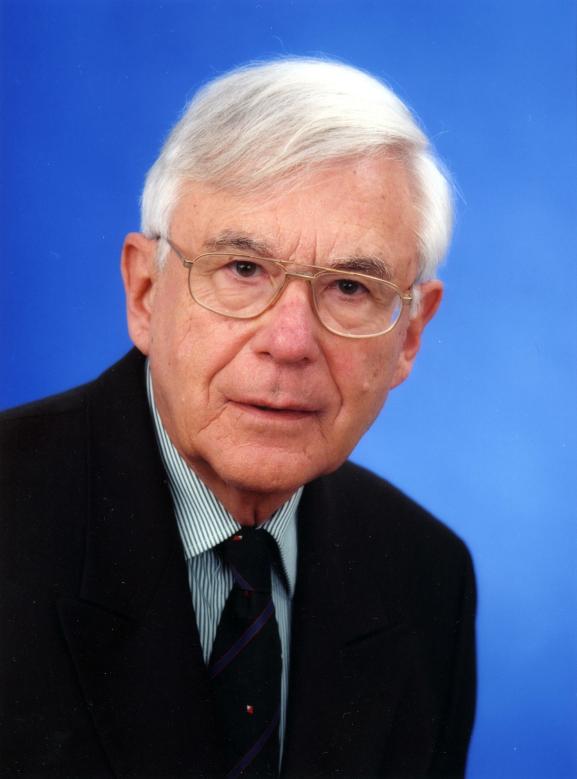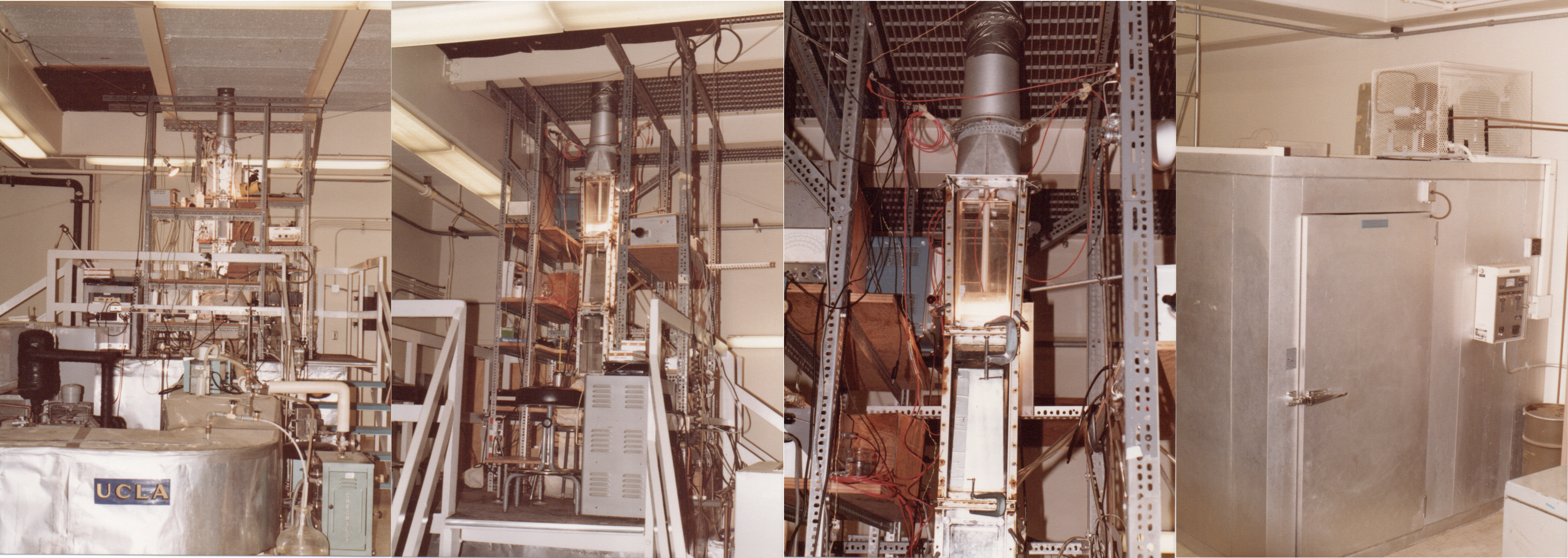
Hans Pruppacher, a giant of the atmospheric sciences, has left us a few days ago leaving behind a sense of loss not only for his scientific contributions, but also for his humanity and tremendous skills as mentor. As his disciple, collaborator and friend of a lifetime I want to remember him for what he really was and for what he has left us. It is not easy to condense in a few words his towering figure, but I will try with great humility and desire to portray one of the great scientists of the XX century.
Hans was the most representative scientist in a field, cloud physics, where he played a fundamental role as scientist, teacher and mentor of generations of students and collaborators. In order to understand his role and scientific contribution I suggest to read the brief paper that we wrote not long ago (Flossmann et al. 2010) in the occasion of the dedication to Hans of the International Conference on Clouds and Precipitation. From this brief note we come to know how Hans, starting from his early studies in his home city, Zürich, dedicated himself to unveil the secrets of the fundamental mechanisms of hydrometeor formation, of aerosol scavenging by hydrometeors, of atmospheric ice, of cloud electrification and much more. He was among the first to realize that a multidisciplinary approach was required to study cloud structure. He encouraged theoretical physicists, chemists, engineers and mathematicians to gather and do what all scientists have done after Galileo: try to model what experiments tell you.
His most famous book is still the undisputed foundation of cloud physics and could only have been written by him because only Hans had a profound knowledge of hydrometeor structure in clouds that came from a deep involvement in theoretical and experimental studies. Microphysics of Clouds and Precipitation (Pruppacher and Klett 2010) is not a textbook for sleepless PhD students. It is a true encyclopedia for those who want to approach cloud physics with the due respect. A humorous story comes to my mind that Hans himself told me when I was working with him at the University of California, Los Angeles (UCLA). While Hans was about to finish his Master studies in Meteorology at the Department of Meteorology of the UCLA at the end of the 1950s and was thinking what to do next to earn his PhD in Meteorology, one of the great scientists in atmospheric sciences of that time, the British Sir Basil John Mason (1923-2015), visited the Department. Upon meeting Hans he asked him: “Pruppacher, I know you want to study cloud physics, right? Well, why? Wouldn’t it be better to work on something more promising since we have more or less learned all we needed to learn?” Hans, a true gentleman, was slightly smiling, but this statement was a real nonsense. Mason had indeed written the first edition of his The Physics of Clouds (Mason 1971), the most important book on the subject at the time and for quite some time thereafter. However, Hans career successively demonstrated that Mason was really wrong and clouds were still hiding lots of secrets! Hans had no fear of difficulties and clearly understood that the word “end” is a nonsense in science. In this sense, he was deeply Socratic: “I know that I know nothing.”
When he became member of the faculty at the Department of Meteorology, then transformed into Department of Atmospheric Sciences, of the UCLA in 1964 among the first things he did was building a vertical cloud tunnel to simulate the atmospheric conditions within a cloud through the creation of an updraft that could float growing hydrometeors. We can see the Cloud Tunnel in the following images. In particular, the third from the left shows the plexiglass section through which we introduced droplets, ice crystals and ice spheres to be floated in the upward moving air column. Through this window we shot photographs and movies and carried out measurements.

At the same time a hollow cylinder 30 m long (the rain shaft) stretched from the roof to the basement of the Mathematical Sciences building. Such a vertical distance was necessary to let raindrop fall at terminal velocity and study their properties as scavengers of aerosol particles and trace gases, such as SO2, at that time in a truly pioneering way. The studies using the cloud tunnel and the rain shaft were the basis for many PhD theses and PostDoc research for more than 20 years and populated the literature on cloud hydrometeors for many years.
Several prizes and honors were given to Hans for his studies. Among these, the Alexander von Humboldt Award in Germany in 1977 and the Second Half Century Award of the American Meteorological Society in 1982 “for his outstanding research in experimental cloud physics, which has provided fundamental data on a wide range of microphysical phenomena essential to the quantitative understanding of clouds and precipitation.”
I think that now, dear reader, it is time to let you almost physically “touch” what meant to do research with Hans, what kind of emotions such studies arose in us, the lucky ones working with him. To do this, I will show you a few “historical” short movies that we produced during those unforgettable moments in the UCLA basement with the high noise of the cloud tunnel in our ears like it were the whistle of the wind in a forming cloud. I hope to have you relive our emotion in front of the plexiglass window through which we could see the floating droplets and hailstones subject to forces of nature that we tried to recreate to better understand the mysteries of a forming cloud.
What happens to a droplet falling within a thunderstorm cloud? Why do we want to know? The thunderstorm cloud is a hostile environment for water and ice hydrometeors. For example, it is populated by severe wind gusts and strong electric fields. The hydrometeors are then tossed in all directions and grow under the influence of a series of superimposed complex physical phenomena. A droplet, in particular, maintains only for a short time its spherical symmetry and elongates substantially in the direction of the strong electric field that surrounds it. We thus need to have an idea of this “warping” to better understand the growth of the droplet and eventually its final breakup. Look now at these two movies:


In the first one a drop of radius 1 to 3 mm is subject to a vertical electric field from 0 to 10 kV/cm. The drop elongates progressively along the vertical and loses its spherical symmetry. In the second movie we see something far more dramatic. The drop is larger and already deformed due to gravity. When the electric field grows to 10 kV/cm the drop elongates along the vertical and we see that vibrations start to appear. The electric force is fighting the surface tension that keeps the drop together and tries to break it. In the end this happens and a liquid water tube shows up at the top of the drop sucking all water out of it. I was the one shooting the pictures that you see below during this experiment at UCLA.

The drop disappears and its water forms a large number of small droplets. The drop size distribution in the cloud is thus substantially modified due to electricity in the thundercloud. We didn’t know these processes until we investigated all this with Has and published the results (Rasmussen et al. 1985).
In summary, we had the sense of “creating” a cloud even though we perfectly knew that everything was kind of “artificial”. However, these experiments still represent the closest perception we have of the effects of the various forces in action on hydrometeors within a cloud. The results we obtained are fundamental because they allowed considerable improvements of cloud models and a better interpretation of radar observations. In other words, they opened an unprecedented window on the interior of the clouds. A small plexiglass window allowed us to have a glimpse on a thunderstorm updraft: is there anything more exciting?
From what we have read before one could think that Hans was a person living detached from reality and thus difficult to approach. After all, he lived in the clouds all day! No, this couldn’t be less true: he was a man like any other. He was kind and very much available to all of us. For many of us, certainly for me, he was a second father. He taught us to be humble while doing research, but also in life, and he was the first to apply these suggestions. He cared for us in these first steps of our careers providing unforgettable advices.I still see Hans at UCLA when he was critically looking at my graphs of the flow field within the liquid layer around a melting hailstone. “Are you sure, Vincenzo? I have the feeling this graph is not right. Maybe I am wrong, but please check, do it for me.” Well, he was right and I was wrong, not even to mention… All this with a very humble attitude in order to make us understand that we have to be respectful to nature that is disclosing his hidden secrets in front of our eyes. I have never forgotten this lesson, never.
I also see him after his retirement when I asked him to come to Bologna and give a seminar to all of us on the discoveries of cloud physics and tell us his opinion on what remained to be done in the field. His answer was lightning fast: “Vincenzo, thank you very much for this invitation, really. I will come to Bologna to see you and have some time together with Angela and your family. However, I don’t think the seminar is a good idea. I am old and far from active research. I would make myself ridiculous.” I didn’t know what to say, but then I thought about it and understood that he was teaching me another lesson: when the time is over one does not have to impose himself on the others. I told myself I will do the same, even though I am worth much less than Hans…
This was Hans for those who knew him and loved him.
Vincenzo (4 November, 2020)
Bibliography
Flossmann, A., V. Levizzani, and P. K. Wang, 2010: On the fundamental role of Hans Pruppacher for cloud physics and cloud chemistry. Atmos. Res., 97(4), 393-395, https://doi.org/10.1016/j.atmosres.2010.06.003".
Mason, B. J., 1971: The Physics of Clouds. 2nd Ed. Clarendon Press, Oxford, ISBN:978-0-19-958804, 671 pp.
Pruppacher, H. R., and J. D Klett, 2010: Microphysics of Clouds and Precipitation. 2nd Ed. Springer, Amsterdam, 954 pp., ISBN:978-0-7923-4211-3, https://doi.org/10.1007/978-0-306-48100-0.
Rasmussen, R. M., C. Walcek, H. R. Pruppacher, S. K. Mitra, J. K. Lew, V. Levizzani, P. K. Wang, and U. Barth, 1985: A wind tunnel investigation of the effect of an external, vertical electric field on the shape of electrically uncharged rain drops. J. Atmos. Sci., 42, no.15, 1647-1652, https://doi.org/10.1175/1520-0469(1985)042<1647:AWTIOT>2.0.CO;2.